Paul DePodesta: The Brain Behind the Browns Rebuild
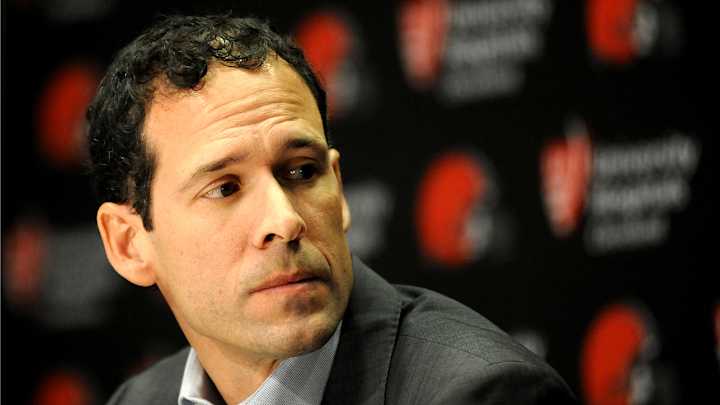
PHOENIX — Paul DePodesta, the Cleveland Browns’ trump card on the rest of the NFL. Nice fellow. Harvard guy, and, to his credit, doesn’t intimidate you with his Ivy League brain. Fifteen months into the new job after two decades with five Major League Baseball teams. Nowhere to go but up. The Browns are in a three-year run with the most high draft picks of any team in football every year: nine in the first four rounds last year, nine in the first five rounds this year, seven in the first four rounds next year. DePodesta, Cleveland’s chief strategy officer, is the mover and the shaker and the Moneyballer in this show. Right?
I spent 40 minutes with DePodesta at the league meetings the other day. I don’t doubt his import to the organization and to the cause of rescuing the Browns from a life of awfulness.
But I still have no idea what he does.
“I think part of that maybe is intentional,” said DePodesta, 44, in shorts and a T-shirt, sitting on a folding chair in a garden at the classic old Arizona Biltmore Hotel. “I’m trying to think of the most succinct way to put it. I really focus on process as much as anything else: process for how we evaluate players, process for how we make decisions, process even for how we hire people internally, process for how we go about integrating our scouting reports with guys watching tape in the office. It is really about how we do the things we do. I think part of the reason they brought me in is because I am completely naive about the National Football League. I have no preconceived notions about how things ought to be done or how they have been done in the past, and I can look at it with a fresh set of eyes.”
“Is there an example you can give me?” I asked.
“I don’t know,” DePodesta said. “We are trying to develop things that ultimately will give us a competitive advantage and will get us back onto the landscape in terms of those competitive teams that are playing in January every year. So, I am hesitant to give away too much of what we’re trying to do. The other reason I think it’s hard is because it is really collective. We have a lot of people in our office who are very bright and have been around the game for a lot longer than I have, who had a lot of these ideas before I ever showed up.”

So I can’t draw the specifics out of DePodesta—which, though I wouldn’t tell him, I actually like, because the last thing you want on your team is some baseball know-it-all coming in to tell the football guys how to win, and the second-to-last thing is then bragging about what you’re doing.
Let’s try something else, then. The one thing that’s obvious about the Cleveland approach—and it has to be a big part of the DePodesta way, seeing that he’s the strategy guy—is the accumulation of draft choices. When he starts talking about that, clues start surfacing.
“We’ve looked ourselves in the mirror and said, ‘Do we think that we are actually superhuman when it comes to picking players?’ And we pretty easily answered that with a resounding no. So how are we going to increase our chances? We need to have more picks. So, if we have the same number of picks every year as everyone else, we don’t expect do better than anyone else.”
“Sounds like Jimmy Johnson’s philosophy,” I said. “You aware of that?”
“Yes,” he said, smiling.
“Had any conversations with him?” I said.
“I’ll keep that to myself. I’ll say this: I’m a big admirer of what he’s done.”
* * *
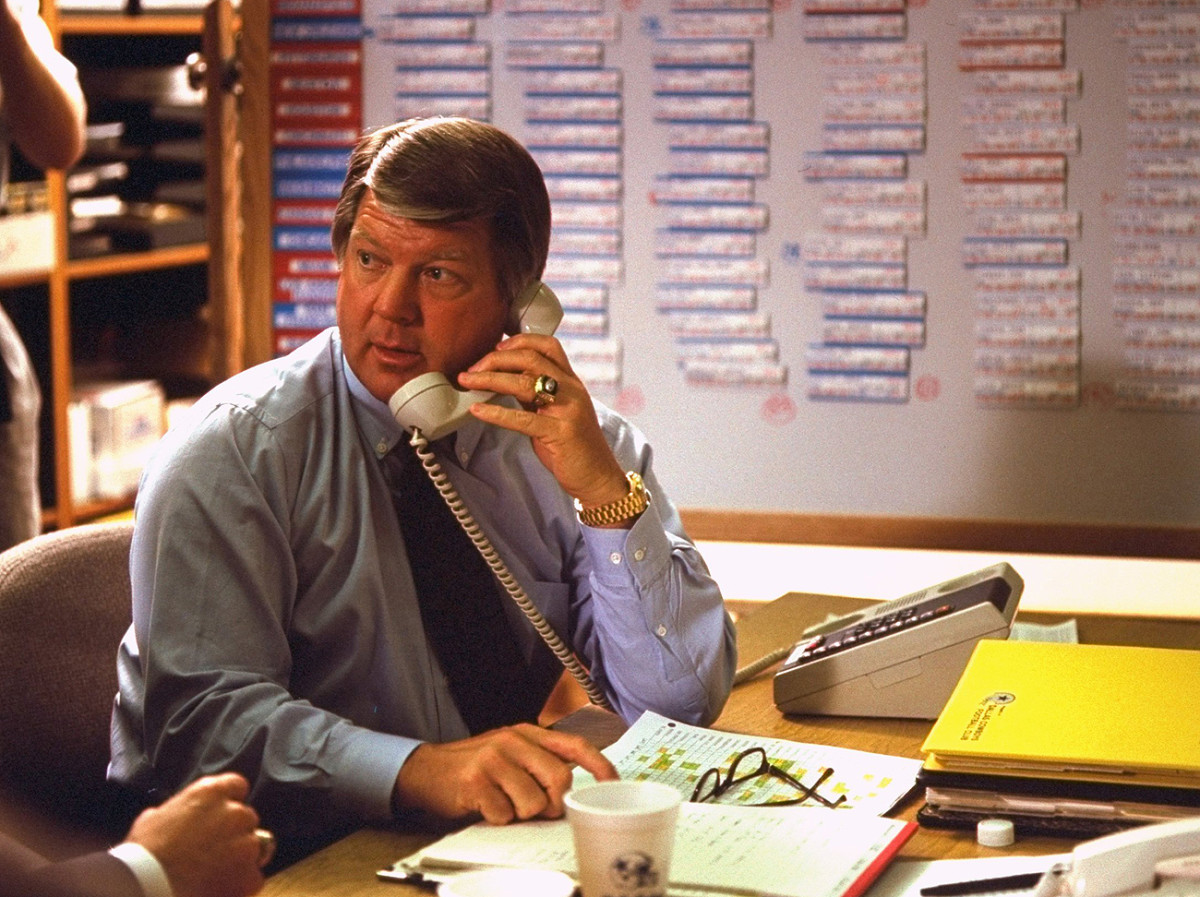
Jimmy Johnson coached the Cowboys from 1989 to 1993. He had a heavy influence on the draft under owner Jerry Jones. By the time Johnson figured out how vital volume of picks was, the Cowboys began to own the draft. See how familiar this looks:
• Dallas, 1991-1993 — Top four rounds of the draft: NFL-high 23 picks.
• Cleveland, 2016-2018 (as of today) — Top four rounds of the draft: NFL-high 22 picks.
Yes, Johnson has spoken with the Browns. He just won’t say about what.
But it’s no deep, dark mystery. Just as acquiring all these picks wasn’t deep and dark. The Browns in 2016 traded the second pick in the draft down to Philadelphia’s eighth slot in the round, and then again to Tennessee at 15. That netted Cleveland seven picks over multiple drafts in the first four rounds.
“That’s good,” Johnson said from Florida on Friday. “There’s strength in numbers. I always wanted to have more picks in the middle rounds and at the end, because you can build a good team with the role players you get in the third, fourth and fifth rounds. With the Browns now, with all those picks, really, you’re one free-agent class and one draft from being a contender.
“But I’ll tell you, here’s the danger of having so many picks: You think, ‘We’ve got so many picks, let’s move up and take that guy with a little risk.’ You think you’ve got so many picks and you can afford to waste them on guys. I never looked at it that way. You have to look at every pick like it’s the only one you’ve got. Like I’ve told Bill Belichick, ‘You don’t have to use ’em this year. Bank ’em. Trade ’em.’ He knows. One time he told me he had a good team, and he had some extra picks, and he was afraid the guy they’d take might not be good enough to make his team. Fine. You don’t like what’s there? You can always find someone to take your four this year for a three next year. Like I said, bank ’em.”
“[Rebuilding a team] is like redoing a house—you need to rip down all the walls and get it down to the studs,” DePodesta says. “When you do that, you look at it and go, wow this looks terrible. We never want to go through this again and I think that is our attitude.”
What Johnson and the Cowboys were so good at was hitting on some of the late ones—and that’s due to the fact that they could afford to err because of the multiple picks. The Cowboys hit on Troy Aikman and Emmitt Smith with first-round picks in 1989 and 1990, back when the draft was 12 rounds long, and in 1991 got Leon Lett in the seventh round and cornerback Larry Brown, a future Super Bowl MVP, in the 12th. “In college I was my own recruiting coordinator at Oklahoma State,” Johnson said. “That helped me later on, because Oklahoma was the top program in the state, and so I didn’t just get the best guys; I had to look for some of the hidden guys. So when you’ve got all these picks, and a lot of them come down the line, you’d better know players.”
There’s the pressure on Cleveland. With 31 competitive front offices, the Browns had better have a cadre of scouts DePodesta and GM Sashi Brown and VP of player personnel Andrew Berry can trust. Said DePodesta: “We don’t get any points or win any games for having the most picks. We need to turn that into talent. It’s part of the reason we are so excited for this April. I think our team will look fundamentally different in May than it does right now.”
It very likely will. But this Browns administration cannot afford to have a B-minus draft. “Cleveland doesn’t have to build their team all this year,” said Johnson. “But after three years, they better have a contender. If they’re not a contender after three years, someone ought to be fired. Simple as that.”
* * *
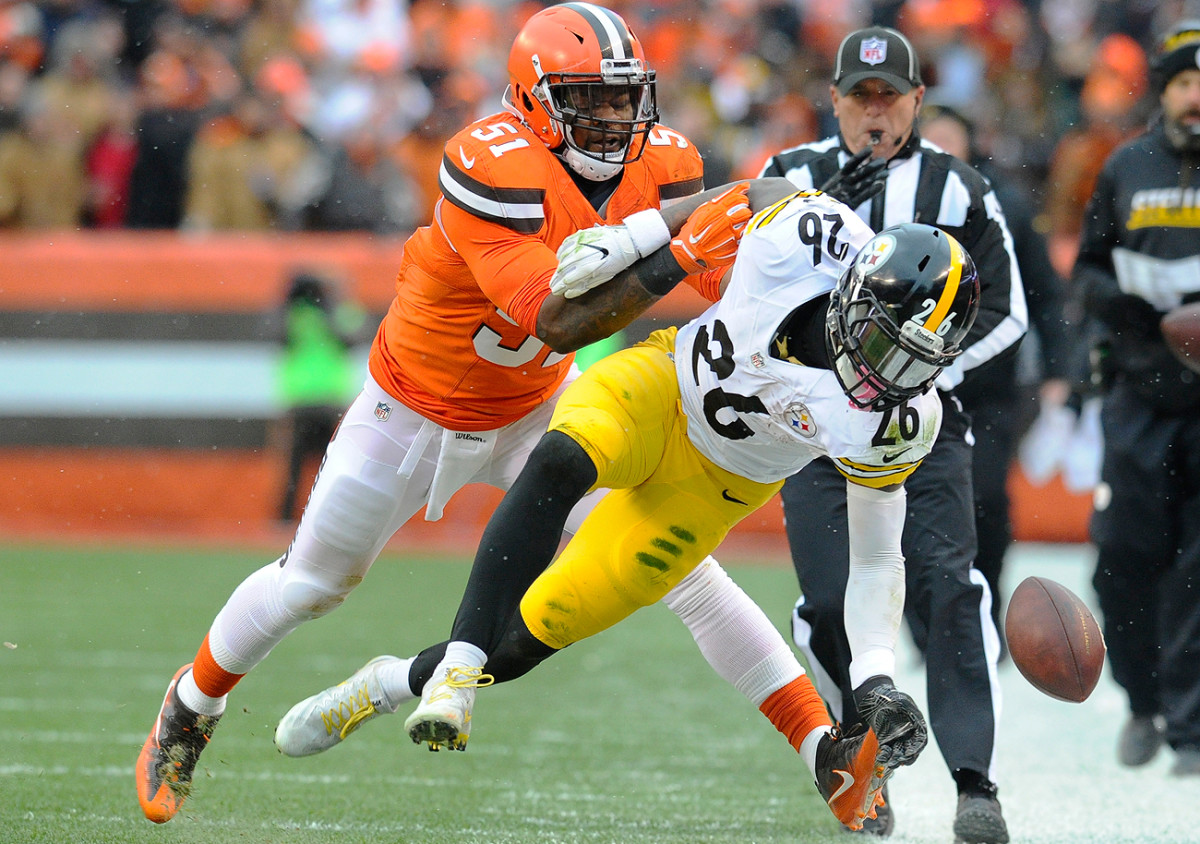
The one thing that bugs me about Cleveland is the loss of too many players they’ve developed. Center Alex Mack and wideout Taylor Gabriel left in 2016 and were keys on Atlanta’s NFC title team. A good right tackle, Mitchell Schwartz, left in free agency a year ago in his prime, at 26, for Kansas City. This year the Browns lost a potential star wide receiver, Terrelle Pryor, after transitioning him from quarterback; they couldn’t bridge a contract dispute, and he signed in Washington.
That’s four holes Cleveland didn’t need to have. At some point—like, now—the Browns won’t be able to justify losing good players on the road to contending. I asked DePodesta why they’ve lost key players whom they probably should have kept.
“Great question,” he said. “I’d say going back a year when we did have a handful of free agents and we allowed them all to sign elsewhere, that was a moment in time. That is not something that we want to do continuously. Again, that was a situation that we felt like we really do need to rebuild the foundation of this organization, and it is almost like redoing a house—you need to rip down all the walls and get it down to the studs. Now, when you do that and you tear out all the walls and the floors and all you have left are the studs, you look at it and go, wow this looks terrible. We never want to go through this again, and I think that is our attitude.
“Even as we got into the season last year, there was a monumental shift in our organizational evolution, and it was when we traded for [New England linebacker] Jamie Collins. What we were trying to show everyone in our organization hopefully, and all our fans, was that that is now behind us and we are adding to this and building; this is not going to be about tearing it down all the time. This offseason we were able to re-sign Jamie, we were able to re-sign [guard] Joel Bitonio, and we added free agents this year. We feel like we’ve got a handful of players that will be part of our core going forward, and our goal is to now build out that core and ultimately, when it comes time, retain it. It did come time right now, with guys like Bitonio and Jamie, we had to retain them and we did. And we will have more players that will be like that.”
* * *
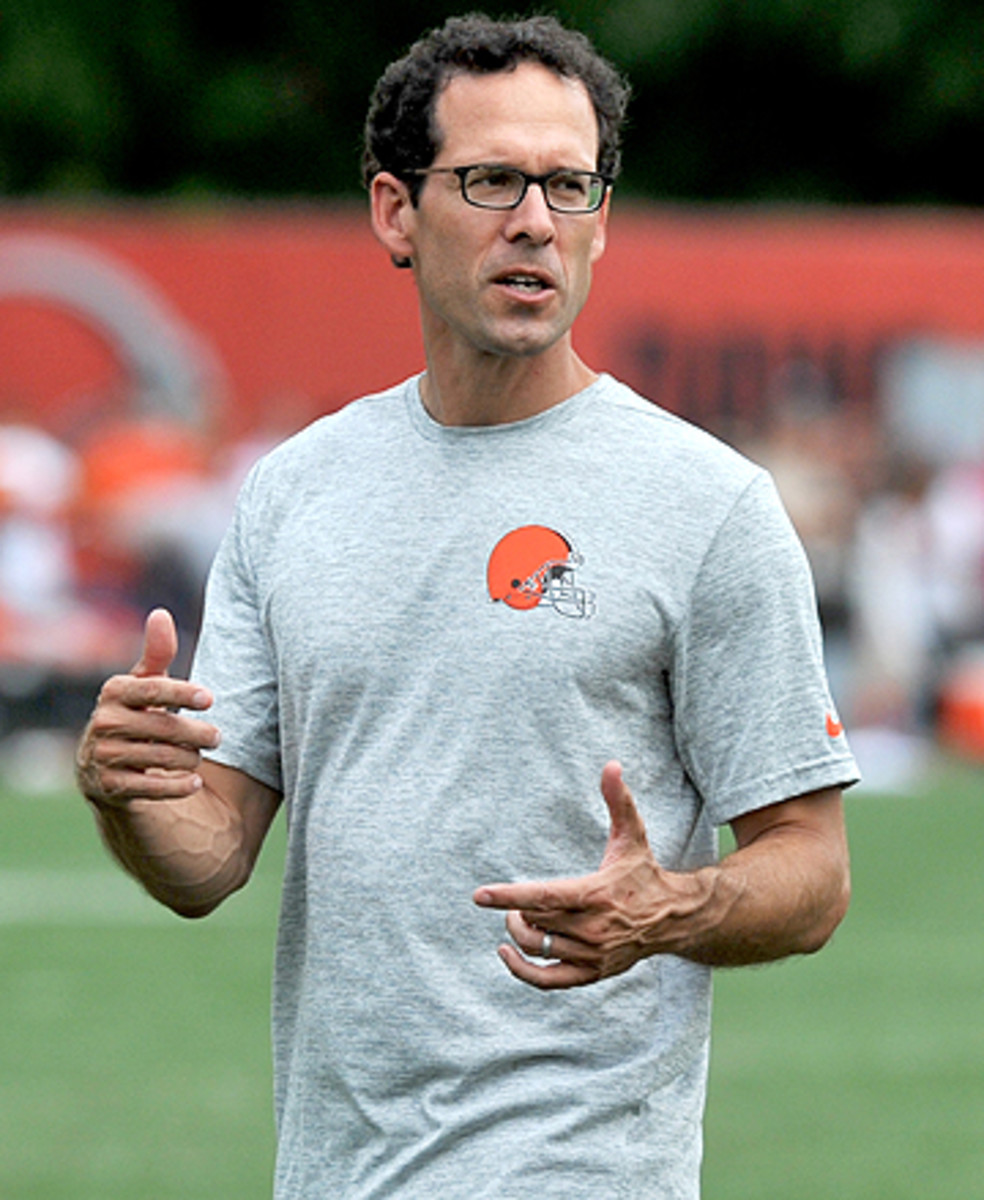
“What translates between baseball and football?” I wondered.
“I’ve actually been struck by how many similarities there are,” DePodesta said. “I have been through similar rebuilding exercises, but I think baseball is different especially because of that minor-league system, where you can see the wave building through the minor leagues. Whether baseball or football, we’re tasked in front offices with making decisions under uncertainty. How do you corral that uncertainty in a way to make more consistently better decisions? That’s very similar. I remember last year, during the free agency period, sitting in a room with a bunch of our scouts, and we were talking about these players, and I remember thinking, ‘I don’t have a 20-year library of players in my head like I did in baseball, so there’s not a whole lot I can contribute to the nuance of this conversation.’ But these are the exact same conversations I have been having for the last 20 years. You try to build a winning culture and bring a group of people together in a short period of time and work them toward a common goal. The competitiveness on a week-to-week basis is the same. The impact of things like injuries is the same. But I still had more to learn about baseball, so that gives you an idea of how far down the learning curve I am with football.”
There’s one simple thing about football, though: The quarterback’s more important than any player on a baseball team. Alex Smith isn’t as good at football as Clayton Kershaw is at baseball, but Smith’s more important to the success of the Chiefs than Kershaw is to the Dodgers.
You don’t win without a good quarterback, and the Browns don’t have a good one, and this year is a tough year for quarterbacks because there’s no sure thing. It’s the continued black cloud over this franchise. Here they are, owning the draft, with the first, 12th and 33rd overall picks, and there’s no Andrew Luck coming in, and probably not anyone close. I believe the similarly needy 49ers may well wait until the 2018 off-season, in either free agency or the draft, to sell souls for a quarterback. It may not be a bad idea for the Browns to do the same, seeing that 2018 is likely to have a better crop of passers—and it could include vets Jimmy Garoppolo and maybe Kirk Cousins.
But in that QB-in-2018 scenario, the Browns would go two straight off-seasons of this new regime without acquiring the quarterback of the future. In the Jimmy Johnson motif, year three would then be a pressure cooker of all pressure cookers.
So there’s nothing easy, and nothing altogether familiar, about this job for DePodesta. Not like his baseball life. By the way, the five teams DePodesta worked for in baseball—Cleveland, Oakland, the Dodgers, San Diego and the Mets—open their baseball seasons today. So I wondered if after the 1-15 Browns season DePodesta has the slightest pang of regret about leaving baseball. “No,” he said. “I absolutely loved my time in baseball, but I am really, really enjoying this challenge.”
He told a story about when the Indians reached the World Series in 1997, when the Browns were two years from being reborn. He said downtown was celebratory after the team won the pennant. “I remember someone saying, ‘This is wild, but you have no idea what this would be had it been the Browns.’ And that always stuck with me.”
If DePodesta ever rides in a Browns championship parade, it won’t be Jonah Hill who plays him in the next movie. There might be a line to play him, led by Leonardo DiCaprio and Bradley Cooper.
* * *
More Nuggets From the League Meetings
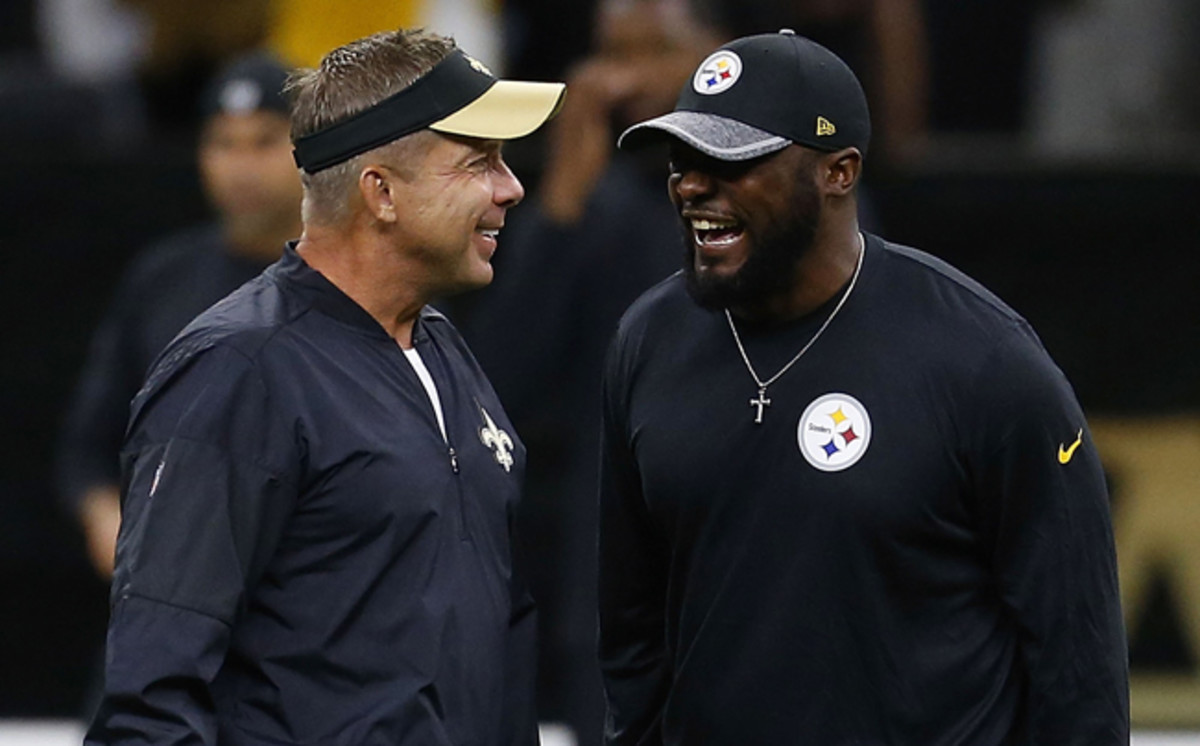
A collection of things I heard and saw and felt at the league meetings.
On the changing face of the NFL
This might just be me, but I don’t think so. One afternoon at the pool at the Arizona Biltmore, the newest, and youngest, head coaches in the league were hanging around like pups with guys we hadn’t thought of as old vets. By the pool on a roasting afternoon, Rams coach Sean McVay (age 31) and San Francisco’s Kyle Shanahan (37) were asking counsel of Steelers coach Mike Tomlin (45) and the Saints’ Sean Payton (53). McVay got introduced to Tomlin a couple of years ago by a Tomlin protégé, Atlanta assistant Raheem Morris, and they’ve spent time at the combine getting to know each other. It’s more McVay picking Tomlin’s brain, but Tomlin gets something out of it too—keeping up with some of the new coaches and some of the new trends in football.
“One of the things I’ve learned to appreciate about Mike Tomlin is you always feel his presence in a room,” McVay said. “He seems like he never has a bad day, and that’s something we want to mimic and emulate. Mike’s been great with how to deal with the team, how to handle adversity, and staying true to your core beliefs. I can’t tell you how much respect I have for him, and I’ll continue to try to bother him for advice.”
Mike Tomlin as elder statesman … that’s different. And Payton has become an advice-dispenser too.
On the Super Bowl rematch
Nothing has changed from my post-Super Bowl opinion that Atlanta at New England is probably not going to be the NFL’s opening game on Sept. 7. One thing I learned in Phoenix that will have a huge bearing on the Patriots’ guest in Week 1: the factor of the new stadium in Atlanta.
The Falcons believe they will play on the road (but not in New England) in Week 1, then open their new stadium on Sunday night of Week 2 against an undisclosed opponent. The NFL will announce the 2017 schedule in mid- to late April.
So if Atlanta opens at home on national TV in an NBC game in Week 2, the Falcons almost certainly will not play on NBC to open the season in Week 1. Which leaves open the best possibility I listed seven weeks ago in this column: Kansas City at New England. Could be Houston, could be Carolina. But my money’s on Kansas City. The fact that the Chiefs have an excellent defense and a competitive offense, and the fact that they’re likely to play the Patriots tough (K.C.’s had one double-digit loss in its past 31 games) gives Andy Reid’s team the best chance to play at Foxboro in game one of 256 in 2017. This way, the league can save Atlanta-New England for a big Sunday night game on NBC later in the season, or for a key FOX doubleheader game.
On the Raiders and London
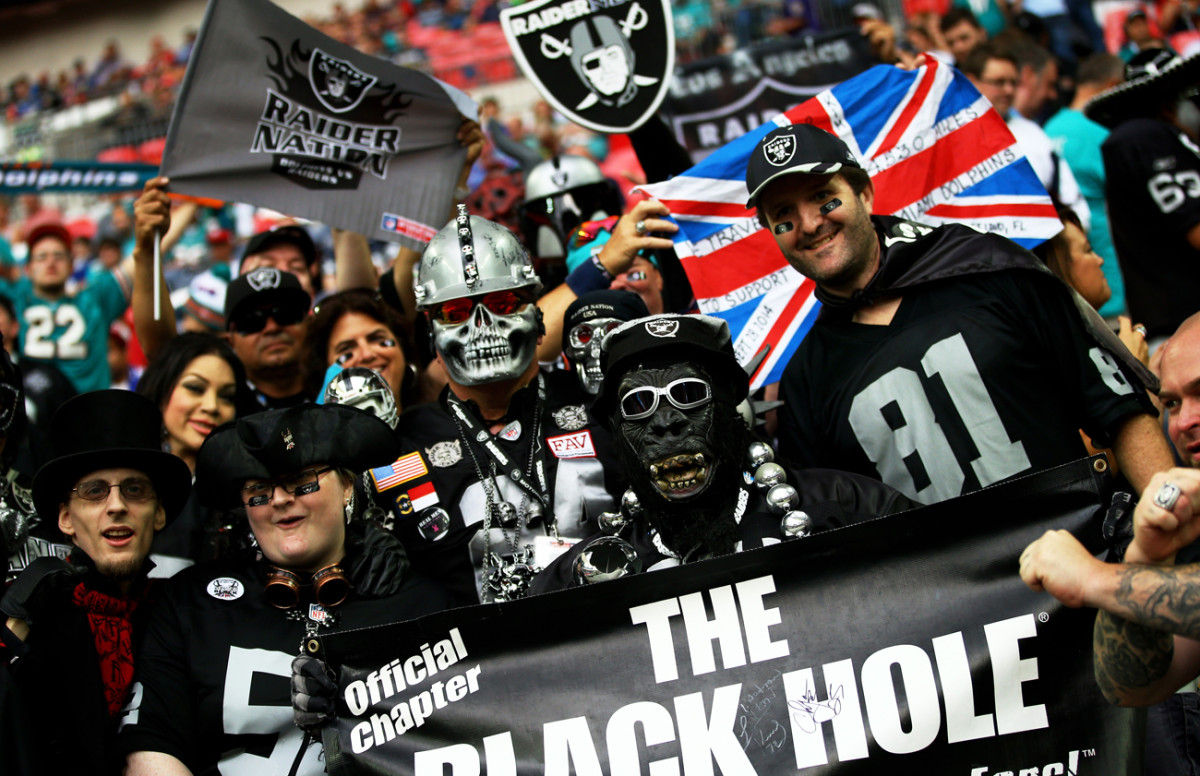
The Raiders will play in 2017 in Oakland, and they’ll likely play there again in 2018, while their new stadium is being built in Las Vegas. As for 2019, it’s totally up in the air. My suggestion: Why not have the Raiders play four home games in London in 2019—say, two in September, two in November? Play them back to back, say in Week 3 and 4 and then in Week 10 and 11 … and the disadvantage the Raiders will have in taking two long trips to London will be made up at least in part by the fact that they’ll build local support by being a “home” team and by the fact that wherever they play that year (unless it’s a slightly larger Sam Boyd Stadium in Vegas, the UNLV home field) will be awkward.
“I love the idea,” said one owner who is very bullish on the NFL putting one of its 32 franchises permanently in London. “I doubt the Raiders will. But that’s not the first time I’ve heard that.” Hmmmm. Interesting.
One other reason the league might be interested in four games in London by one team? Assuming the NFL keeps the current format of four games by other teams on the 2019 calendar, it would be a chance to test the fervor of fans for eight games, perhaps by first offering season tickets to the eight games. The league is selling four-game season-ticket packages this year, and already 40,000 season seats have been purchased. So far, the league has sold out 16 of 17 regular-season games in London, with one game in 2011 falling 7,000 tickets short because they went on sale late due to the threat of a lockout that season.
On the Raiders’ move
To put it mildly, the reaction to the Raiders’ move from Oakland to Las Vegas at the meetings was muted. The Las Vegas backers were fired up, of course. But even though the owners voted 31-1 in favor of the move, it wasn’t an enthusiastic vote of confidence that they love Las Vegas; it was more resignation that the Raiders would never get a good stadium built in Oakland unless owner Mark Davis agreed to take on a partner. Which, unfortunately for Oakland, he refused to do. I’ve written this several times, but Davis probably could have found a 50-percent partner who would have been a keystone to building a stadium in northern California, the same way the Mara family merged with the Tisches in 1991 when the cost of doing NFL business became too high for one family without significant income elsewhere. Easy for me to say that Davis should have sold half his team; I understand it’s his call. His father, the late Al Davis, steadfastly refused to cede any control of the franchise to partners. Ditto Mark Davis.
Look at a map of the Bay Area. Look at San Jose, on the southern end. Right next to San Jose is Santa Clara, where the 49ers play. Up in Oakland, 42 miles north of San Jose, is where the Raiders will be leaving. To get from San Francisco, Oakland and Berkeley to see the 49ers is a solid hour in the car. And I can tell you that what concerns the league now is the fact that the northern part of the Bay Area, the sixth-largest market in the country, is now going to be without an NFL team. With so much money, and so much fan interest, having one team and having it at the southern end of the region, with nothing at the northern end, is disconcerting.
The fans in this region already are turned off by the 49ers, and it will take a rally orchestrated by GM John Lynch and coach Kyle Shanahan to get them excited again. The Raiders were being built into a power, the kind of team fans from all over the Bay Area could have learned to love. Now, the Raiders may not even be loved in the next two years inside the Oakland Coliseum. Maybe a fabulously wealthy Silicon Valley entrepreneur will spearhead a drive to pick off a struggling NFL team and move it west in the next three or four years, and lead the building of a new stadium. If not, the NFL will miss the greatness of this region at a time when it’s continuing to explode (in a good way) economically.
Somehow the NFL has to figure a way to stop the bleeding in great football regions like San Diego and San Francisco/Oakland. It’s not going to be easy. But there are too many great fans of pro football in California getting slapped in the face with the moves of these two franchises. That’s one of the reasons no NFL owner or executive was celebrating the move of Oakland to Las Vegas … and the Chargers in Los Angeles as a second team makes absolutely zero sense either. The Chargers in L.A. and the Raiders in Vegas are good for the NFL’s business. But there’s nothing else good about either move.
On the longevity of football players
Interesting response when Saints coach Sean Payton was asked about players—such as Tom Brady and Drew Brees—playing so much longer than those players of past eras. “There’s an old picture I’ve seen, and Archie Manning has it,” Payton said. “It’s Len Dawson at halftime, and he’s smoking a cigarette. I think in the last five years really, we have seen it happen with golf and we’ve seen it happen with various athletes. How we look at training, sleep and nutrition is entirely different than not too long ago. When I played in college, and I like to think that that was a short time ago and I know it was not, but we did not drink water during workouts. It was frowned upon. There were certain things that were just madness. As we have learned and evolved and if you take these elite athletes that are driven with the same mindset, it is interesting how they have pushed that bar.”
On Adrian Peterson
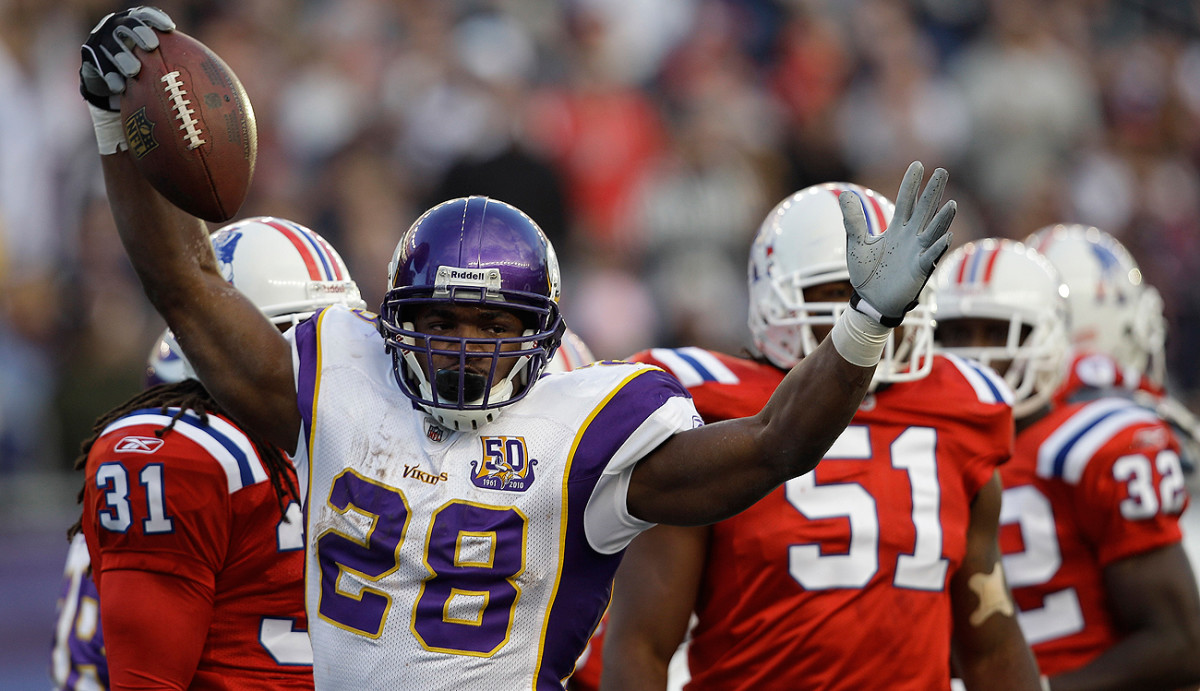
Just what does it mean that Adrian Peterson is visiting New England? I doubt that it’s very much, but you never know. Unless Peterson is willing to take very little guaranteed money, I wouldn’t expect he’d sign with the Patriots. Adam Schefter reported Sunday that Peterson will spend the day in Foxboro. Bill Belichick is not a sentimental guy who signs 32-year-olds who have had one great season in the past three years, particularly at a position the Patriots use as a train station. Dion Lewis, James White and ex-Bengal Rex Burkhead will account for $5.4 million of the Patriots’ cap in 2017, according to Spotrac, which means two things: They could afford to spend more at the position without crippling their budget … and Bill Belichick never spends big on backs, particularly backs like Peterson who would be dead weight on New England’s special teams. Peterson likely wouldn’t play them.
For now, I’ll believe this is a fact-finding mission for a veteran who would certainly help the Patriots. But only if he takes very low pay. A good example is defensive end Chris Long, who could have probably tripled his $2.375 million salary in 2016 had he signed with one of the other teams that pursued him a year ago. But he signed with the Patriots, earned his Super Bowl rin, and then left for the Eagles. I know Peterson says he’ll play for not very much and winning is the most important thing for him. But it’s hard for me to believe he’ll sign with the Patriots for, say, $4 million in total 2017 income.
* * *
Quotes of the Week
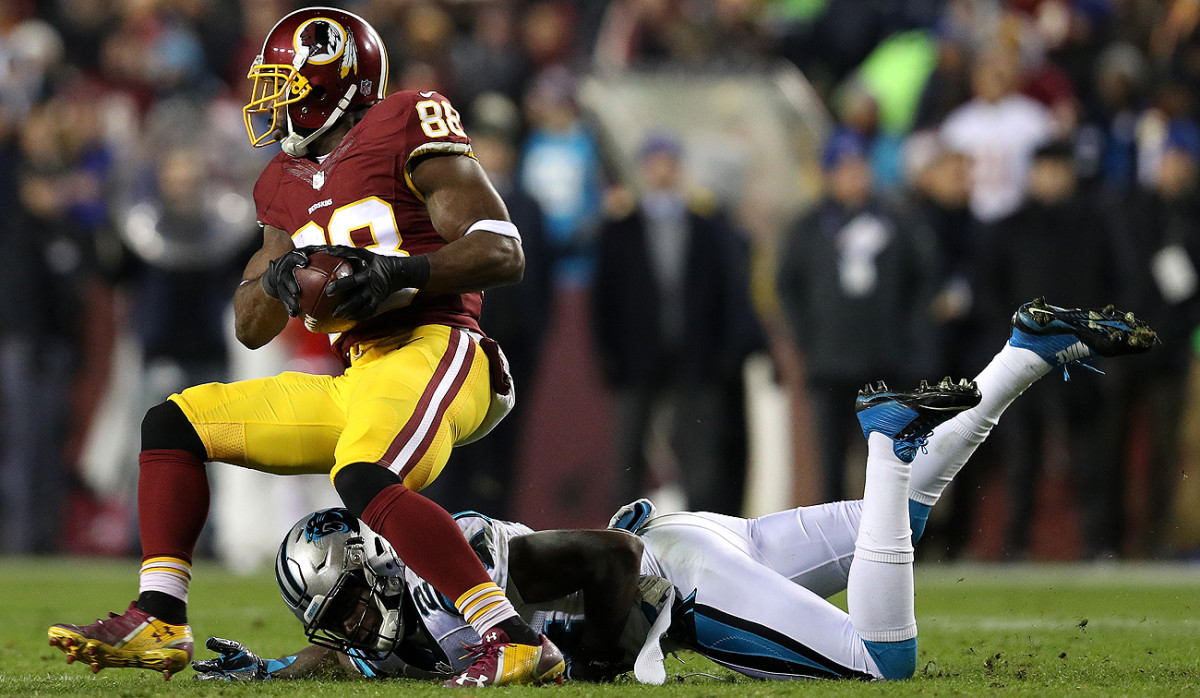
I
“Now they’re part of a normal college experience, you know? And I reminded them that this is not normal. This does not happen in real life, and what you’re experiencing right now, this is real life.”
—UConn coach Geno Auriemma, to ESPN, after Mississippi State beat the Huskies on a buzzer-beating shot in overtime 66-64 to end UConn’s 111-game winning streak.
Excellent perspective. If you’re Mississippi State, it’s the game of a lifetime. If you’re UConn, it’s the reality of sport. If you’re a women’s college basketball fan, it’s a great thing for the game. Goliath can lose—and Goliath can lose to a team in a game that was not a fluke. Mississippi State was better, and fought a great team gallantly for 45 minutes. Terrific ballgame.
II
“There was zero distraction. He met with the team immediately after [his first protest]. He met with the other team leaders. He explained his position and where he was coming from. And literally, that was it. Colin was focused on football.”
—Chip Kelly, who was Colin Kaepernick’s coach with the 49ers last year, on the fear that Kaepernick’s outside interests in social justice would cause disruption on a football team, to Michael Rosenberg in a nuanced and smart column for The MMQB.
III
“I’ve always loved Pierre Garçon because of how angry he plays.”
—New 49ers coach Kyle Shanahan, on his new wideout (who he also coached in Washington).
IV
“Some of the guys who are going to be worrying about Vegas won’t be going to Vegas.”
—Raiders coach Jack Del Rio, on this week’s “The MMQB Podcast With Peter King,” meaning that by the time the Raiders play in Las Vegas, in 2019 or 2020, the majority of the roster will have turned over from the current team.
V
“I'm not sure avocado ice cream is right for me, but if I could look like him and perform half as well, I guess I'd do it."
—New England owner Robert Kraft, at the NFL owners meetings last week, discussing one diet staple of soon-to-be-40-year-old quarterback Tom Brady.
VI
“Zero pushback. Zero … One thing we’re really good at as a league is adjusting to change. But one thing we’re not very good at as a league is being receptive to change.”
—NFL Competition Committee chairman Rich McKay, when I asked him if there’d been any pushback at the league meetings in Phoenix to the PAT line being moved back from the two- to the 15-yard line two years ago.
McKay’s answer is perfect. At the time, moving the PAT was decried by many as creeping over-rulesmaking, fixing a play that wasn’t broken. But it was broken; it was a non-competitive play. Now it’s an interesting play. Instead of kickers making slightly more than 99 of 100 PATs, which was the prevailing percentage, kickers over the past two seasons have converted about 93 percent of them.
* * *
Stat of the Week
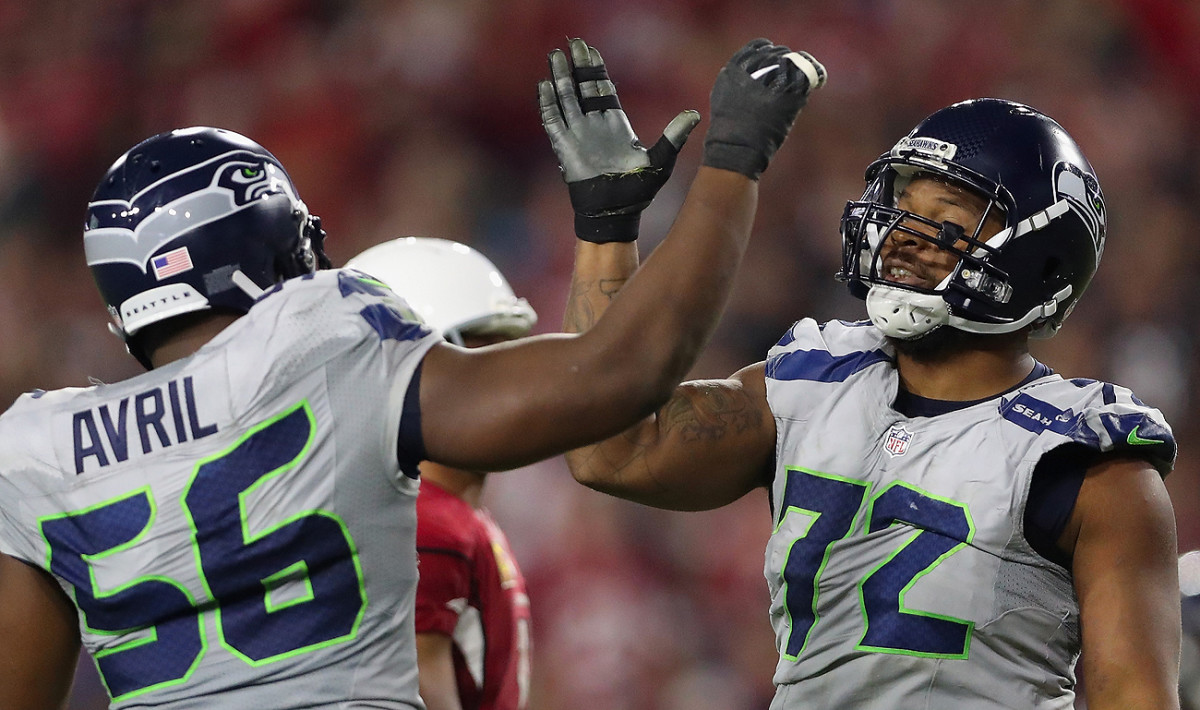
The age of the Seattle defense got me thinking the Seahawks better win now. Like, right now.
Looking at the 12 most significant players on the defense (and part of this is a projection on my part, because jobs will be won and lost between now and opening day), 10 will be between 27 and 31 years old on Sept. 1. So as much as GM John Schneider would like to get (at least) one more offensive lineman in this draft, I think he’d better concentrate on replenishing the defense as well. The ages of Seattle’s prime defenders at the start of the 2017 season:
31: Michael Bennett, Ahtyba Rubin, Cliff Avril
29: Richard Sherman, Kam Chancellor, DeShawn Shead
28: Earl Thomas, K.J. Wright
27: Bobby Wagner, Jeremy Lane
24: Frank Clark, Jarran Reed
* * *
Factoids That May Interest Only Me
I
Mark Davis confirmed to me that he copyrighted “Las Vegas Raiders” in 1998. He would not tell me why he did that 19 years ago, but his business “guess” came true.
II
Income Hilarity of the Week:
Athletes | Current Status | 2017 Earnings |
|---|---|---|
Carl Crawford | Out of baseball since June 2016 | $21.8 million |
Von Miller and Khalil Mack | Top NFL defensive players | $19.97 million total |
Miller and Mack will make less money combined to tear apart NFL offenses than Crawford will make to sit out the baseball season—assuming no one signs him.
III
The Mississippi State-UConn basketball game Friday night was tied at 40, 44, 46, 48, 50, 52, 56, 60, 62 and 64.
* * *
Mr. Starwood Preferred Member Travel Note
Best spring-training feature of the Cactus League: the free 30 SPF sunblock at the Rockies/Diamondbacks home field.
Runnerup: the wiffleball fields at the home of the Cubs and Rockies/D-Backs, both packed with kids.
* * *
On Their Night Table
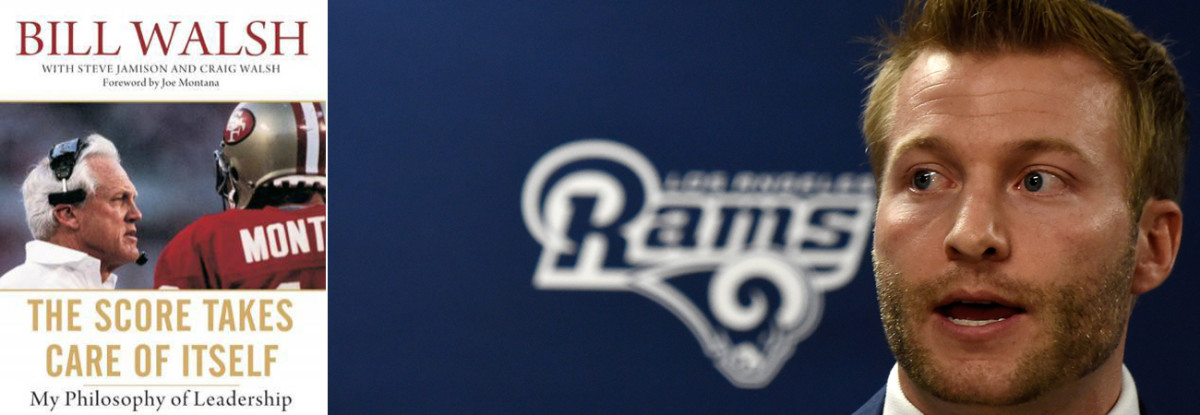
The Score Takes Care of Itself: My Philosophy of Leadership, by Bill Walsh
Recommended by Rams coach Sean McVay
“I love the book,” said McVay. “I read a lot. I read to learn about great leaders, mostly. In this book, Bill said, basically, ‘Focus on the little things with precision and detail. Focus on daily improvement.’ That speaks to so much of what a football team should do.”
* * *
Tweets of the Week
I
ppl can say literally whatever they wanna say...but idc, I will LITERALLY sit out the WHOLE YEAR before I decide to play on the tag!
— Le'Veon Bell (@LeVeonBell) April 1, 2017
II
Said it last year, feeling it again: Mock drafts are like your kids. At some point, you have to let them go and let them experience failure.
— Sam Farmer (@LATimesfarmer) March 31, 2017
III
Newlywed Couple Holds Wedding Reception at In-N-Out in San Gabriel Valley https://t.co/Pp72IdVHUE pic.twitter.com/6h1rMBfkT6
— KTLA (@KTLA) April 1, 2017
IV
An Indonesian man disappeared. Then his body was found — inside a python. https://t.co/8KOGiU9ACV pic.twitter.com/imgCfPdVHp
— The Boston Globe (@BostonGlobe) March 30, 2017
V
Man growing up in the bay not gonna be the same. I feel bad for you young pups.
— T.J. Ward (@BossWard43) March 27, 2017
The Denver safety—born in San Francisco, attended high school in Concord, Calif.—on the loss of the Raiders for Oakland.
VI
Ten Years Ago Tonight: @realDonaldTrump wins Wrestlemania 23 "Hair vs Hair" with Vince McMahon at Ford Field in Detroit pic.twitter.com/GKAQon8ruc
— Darren Rovell (@darrenrovell) April 1, 2017
* * *
Pod People
From “The MMQB Podcast With Peter King,” available where you download podcasts.
This week: Competition Committee chairman Rich McKay, Raiders coach Jack Del Rio, and veteran San Jose Mercury Newscolumnist Mark Purdy—on the effect of the Raiders’ move and the future of pro football in the Bay Area.
• McKay on the rules proposal reducing regular-season overtime periods from 15 minutes to 10 getting tabled: “I think it caught some people by surprise. This year we did not have a week between our competition committee meeting and our owners meeting, which we typically do. During that week we send all the proposals to the clubs; we have conference calls and go through the proposals to the clubs and we have a chance to let them understand our reasoning. In this case we didn't, because we didn't have enough time based on the calendar this year. I think people were caught by surprise. Some of them put their hands up and said, ‘Hey, if I had to vote today, I'm not sure I would support.’ So I took the position of fine, let's make sure we show you all the data. Number one, we are going to propose it for one year only so that people could see the results. Number two, it's only in the preseason or regular season, and it is based on the number of snaps that a player has to play. Our concern is that we don't know what comes behind it, whether that is a game on Thursday night or travel across the country, all those things. I understand. I have been down the overtime path before. People get very nervous about changing overtime. We'll get back to it.”
• McKay on why he favors the proposal: “Player safety. Overtime is extra. And to us, we don't want too much extra. We're averaging about 17 plays per overtime. This year that average went all the way up to 22, only because we had three games that went the whole way. … Those are the games that concern us. Our feeling is that with 10 minutes, you're going to get the great, great, great majority of the games decided.”
• McKay on the passage of centralized replay in the New York officiating center: “Now you have a chance to make consistency even better. Because instead of having those 16 referees that are working on Sunday, looking at it through their own little lens, you have one lens and that is at central command with [officiating execs] Dean [Blandino] or Al [Riveron] or whoever the officiating supervisor may be. ... I think if you ask coaches, when it comes to officiating what is your number one goal? It's consistency. People will say accuracy but it's consistency. They want to know when something happens, what is going to happen from crew to crew? I think that is what this central command will do for us.”
Coming up in my next podcast, available Wednesday: Indianapolis general manager Chris Ballard, Atlanta coach Dan Quinn. Subscribe here.
* * *
Ten Things I Think I Think
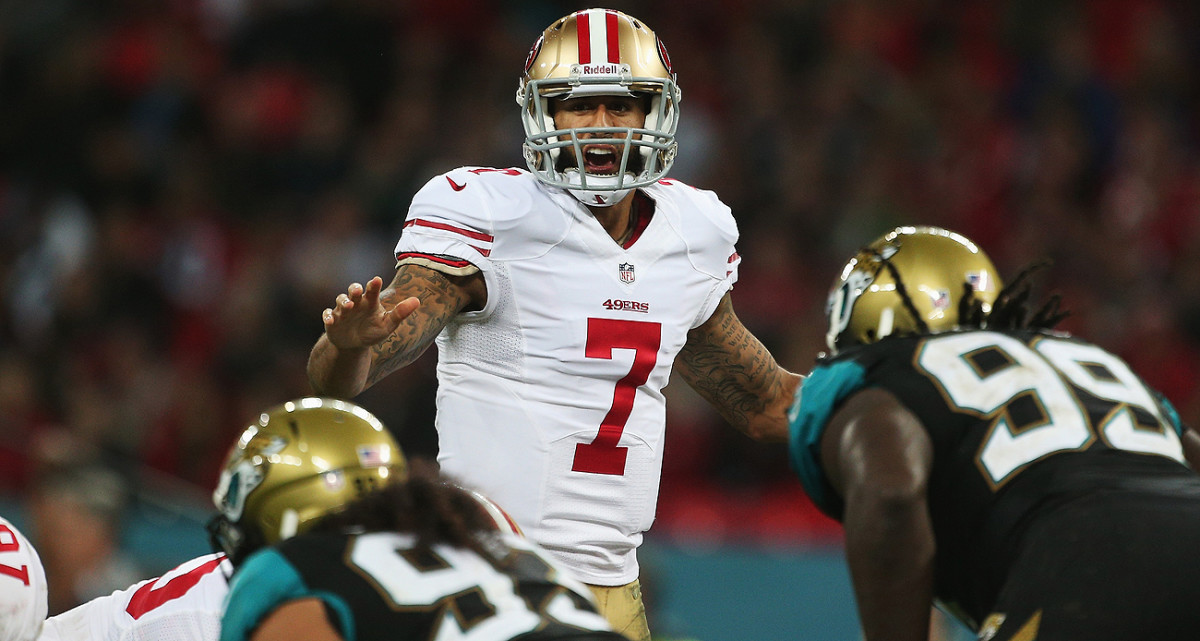
1. I think we’re on a pretty amazing run in sports over the past calendar year:
April 4, 2016: Kris Jenkins hits a three-point shot at the end of regulation to give Villanova a 77-74 win over North Carolina in the NCAA men’s basketball national championship game.
April 26: Kobe Bryant, in the last game of his career, scores 60 points, and the Lakers beat Utah 101-96.
June 19: On the road, rebounding from a 3-1 series deficit, the Cleveland Cavaliers stun Golden State with a late three-pointer from Kyrie Irving to win the NBA title, 93-89. It’s the first major pro sports title for a Cleveland team in 52 years.
Nov. 2: On the road, rebounding from a 3-1 series deficit, the Chicago Cubs stun Cleveland 8-7 to win the World Series. It’s the first World Series title for the Cubs in 108 years.
Nov. 12: In college football, the 112-game regular-season winning streak of the Mount Union Purple Raiders ends when the John Carroll Blue Streaks throw a touchdown pass with 39 seconds left in a 31-28 victory. Mount Union had been 222-1 since 1994.
Jan. 9, 2017: Deshaun Watson throws a two-yard touchdown pass to Hunter Renfrow with one second left in the college football national championship game, and Clemson stuns Alabama 35-31.
Feb. 5: Down 28-3 with 20 minutes left in regulation, the New England Patriots rally to beat Atlanta 34-28 in Super Bowl 51.
March 31: Morgan William hits a 14-foot running shot at the buzzer in overtime, and Mississippi State ends UConn’s 111-game winning streak in the NCAA women’s basketball semifinals, 66-64. It’s the first loss for UConn in 866 days.
2. I think the best fit for Colin Kaepernick is Jacksonville. And I don’t want to hear anything about how bringing in Kaepernick is going to be a knock to the confidence of Blake Bortles. This is a performance business, and Bortles held back a team with his poor play last year. The Jaguars can’t risk 2017 being a rerun, not with the money and draft capital they’ve spent to build a good defense.
3. I think this vegan stuff with Kaepernick is the stupidest kind of nonsense. I’m sure I’m the 492nd to say this in the past few days, but Tom Brady is a near-vegan.
4. I think, with Cam Newton beginning rehab of his surgically repaired right shoulder today in Charlotte, it’s going to be very interesting to see if he’s ready to throw the ball as normal come training camp. Newton injured the rotator cuff in his throwing shoulder Dec. 11 against San Diego, and the Panthers, hopeful that it would heal on its own, waited 109 days before choosing to have surgery last Thursday. Training camp opens in 16 weeks. Newton wasn’t the same quarterback in 2016 as he was in 2015; completion percentage fell from 60 to 53 percent, and TD-to-pick differential declined from plus-25 to plus-5. If Newton can’t participate in a camp that’s vital to him and the offense after last year’s struggles, the Panthers erred in waiting so long to have the surgery done.
5. I think the interesting piece by Mike Florio on Saturday—that the owners held a secret meeting at the NFL meetings, and, according to Florio, Jerry Jones asked for a more liberal policy for marijuana and for more oversight on Roger Goodell’s salary—makes an awful lot of sense to me. Penalizing marijuana use the same as harder drugs is ridiculous in this day and age, and Goodell’s salary and benefits being more than $30 million annually has always seemed excessive to me.
6. I think you can play these games all day, but the way I’d look at the Dion Jordan disaster for Miami is this: Before the 2013 draft, Miami held the 12th and 42nd overall picks in the first two rounds. GM Jeff Ireland traded 12 and 42 to move up to three. With the third overall pick, the Dolphins selected pass-rusher Dion Jordan of Oregon. On Friday, Miami released Jordan, who played 26 NFL games in the four Miami seasons since the draft, and had as many substance suspensions (three) as career sacks. This was a flop of colossal proportions, one of the biggest busts of this century. Here’s what has to hurt worse: Miami didn’t use one high pick on Jordan; it used two. And in slots 12 and 42, the Dolphins could have selected defensive tackle Kawann Short or cornerback Xavier Rhodes with the first pick, and Le’Veon Bell with the second one. That is the kind of decision that can set a franchise back years.
7. I think the signing of free-agent defensive end Chris Long in Philadelphia—for a long-term deal that seems destined for him to play at least two years with the Eagles—had a couple of interesting messages. One: Long saw his role and playing time slashed late in his Super Bowl season in New England; he played 62 of 188 snaps in New England’s three postseason games. Playing a third of the snaps in the biggest games of the year must have stung. Clearly the Eagles have more planned for Long, using a scheme that he believes will fit him well. Two: Long, by his own words in Philly on Friday, wanted to emphasize how strongly he felt about his future at 32. He said last year in New England, “I didn’t miss a practice, I didn’t miss a game, and that was something that I was very proud of.” He seemed like a guy happy to have a chance to finally get a Super Bowl ring after never making the playoffs in eight seasons with the Rams. But he also seemed like a guy saying, I can do more than I did in the postseason in New England, and I’ll show you now.
8. I think my reaction to the NFL holding the 2017 NFL draft outdoors in Philadelphia is this: Waiiiiiit. Outdoors? You know what April 27 MIGHT be like at night in Philly? The NFL’s got to be thinking, after a lucky temperate Super Bowl in the Meadowlands, that it can control the weather in the northeast. I am a veteran of March and April baseball and softball in New Jersey and New York, and I can tell you: April 27 always has a chance to be like Feb. 27 in this part of the world.
9. I think as I sat at the Biltmore bar one night at the league meetings, and a few feet away stood former Eagles tackle and current NFL exec Jon Runyan, who towered over his bar-mates, I had this thought: Jon Runyan is Paul Bunyan.
10. I think these are my non-football thoughts of the week:
a. South Carolina is a really tough basketball team. Gonzaga’s tougher.
b. Box out, Oregon. Box out.
c. I’ll take Gonzaga tonight, but that is the least-trustworthy prediction of the title game in America. I have not watched a complete college basketball game all season.
d. Loved this story about the monumental Mississippi State win over UConn—and SI.com’s Richard Deitsch wrote it on deadline.
e. Story of the Week: by Gregg Doyel of the Indianapolis Star,about the compassion and kindness of fired Indiana coach Tom Crean.
f. Netflix Show of the Week: Cannot believe I hadn’t discovered this before the other night, but “Chef’s Table,” is one of the great series on TV. You’ve got to watch the episode of L.A. chef Nancy Silverton (of Mozza), mostly for the cooking, but also for the incredible HD video of Silverton’s Italy. If you’ve got a good TV, the Italy images are breathtaking. Good stuff about her quest for perfection in pizza dough too.
g. In honor of the opening of the baseball season:
h. I love box scores.
i. I love the Cactus League. It is a phenomenal thing, to see two or three games in searing heat, after spending week after week in the sleeting cold. The Cubs stadium in Mesa, the Rockies/D-Backs place on a Native American reservation … those places are perfect. Just perfect.
j. My MLB playoff picks: (American League) New York, Cleveland, Texas. Wild Cards: Boston, Houston. (National League) Washington, Chicago, Colorado. Wild Cards: Los Angeles, San Francisco.
k. World Series: Houston over Chicago, 4-1.
l. MVP: Rougned Odor, Texas (AL), Kyle Schwarber, Chicago (NL).
m. Cy Young: Masahiro Tanaka, Yankees (AL), Kyle Hendricks, Chicago (NL).
n. Coffeenerdness: You dropped the smoked butterscotch latte, Starbucks? Give me one good reason. (I am begging.)
o. Beernerdness: Controversial choice this week. I’ve been a fan of the vague, mild fruit tinge to a wheat beer. But this one, Orange Blossom Mandarin Wheat Beer (Papago Brewing, Scottsdale, Ariz.) has a more pronounced orange taste—and it’s fantastic. Maybe that’s because I had it on a broiling day watching Rangers-Rockies at Salt River Fields at Talking Stick. (Come now: What kind of name is that for a spring training park?) But it’s been a while since I had such a refreshing, distinctive beer.
p. I know I tell you to watch Steve Hartman of CBS a lot, but this piece is an excellent reason why.
* * *
The Adieu Haiku
Morgan William might
be more famous in Starkville
than one Dak Prescott.
• Question or comment? Email us at talkback@themmqb.com.
